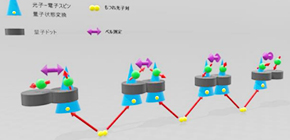
Method for efficiently conversing quantum state from photons to electron spins
Will promote the realization of quantum dot technology that allows completely secure information communication
The development of the Internet of Things (IoT) will drastically increase the amount of information handled in society, which will in turn increase the importance of keeping personal information safe and secure. Completely secure communications technology is necessary in solving this challenge. Quantum cryptography communication is highly anticipated as a means of secure communication and its research and development are currently underway.
A group of researchers led by Professor Akira Ooiwa at the Institute of Scientific and Industrial Research, Osaka University is pursuing research and development of quantum repeaters that allow for long-distance quantum communication.
Long-distance communication is the most critical issue in quantum communication, but methods and devices for achieving it have not yet been established. Thus, this group aims to realize quantum repeaters by using electron spins in gate-defined quantum dots (QDs). Currently, they are engaged in accurate quantum state conversion from photons to electron spins and the realization of entanglement conversion from a photon-photon pair to a photon-electron spin pair.
There are, however, various technical challenges, one of which is the conversion efficiency from photons to quantum bits. Eventually, this will be related to the transmission rate of quantum information. However, a quantum bit is generally small in size, so efficient coupling between a photon and a quantum bit was not easy, making it a common challenge.
The group proposed a method for efficiently irradiating quantum dots with photons by combining a gate-defined QD with a bull's eye structure. Through computer simulations, they demonstrated that surface plasmon effects increased conversion to one electron in one QD about 50 times more efficiently. They proposed that a surface-plasmon antenna was an effective method for drastically increasing the conversion efficiency from photons to electron spins for the first time.
If it becomes possible to achieve basic technology for quantum communication using electron spins in gate-defined QDs, it will accelerate the realization of quantum communication, contributing to absolutely secure information communication technology and a safe society. In addition, while their surface plasmon antenna is particularly effective in semiconductor QDs, it can also be applied to other quantum bits, so it will be widely used for enhancing the transmission rate in long-distance quantum information communication and will contribute to fundamental technology for building a safe and secure society.
Abstract
Quantum repeaters are required for realizing long-distance quantum communication. The quantum repeater consists of a quantum memory to store quantum information and an interface between photonic flying qubits and the memory qubits. Electron spins in gate-defined quantum dots (QDs), which have a relatively long coherence time and high electrical tunability, are promising candidates for such memory qubits because the fundamental technologies of detecting and manipulating single photoelectron spins have been established. The remaining challenge for the realization of quantum repeaters is an efficient coupling between photons and electron spins in the QDs. In this study, we discuss the enhancement of the transmission and the maintenance of the incident light polarization through bull's eye structures on gate-defined QDs on the basis of electromagnetic field simulations.
Figure 1
Figure 2
The article, “Design of bull's eye structures on gate-defined lateral quantum dots”, was published in Japanese Journal of AppliedPhysics at DOI: 10.7567/JJAP.56.04CK04
Related link
